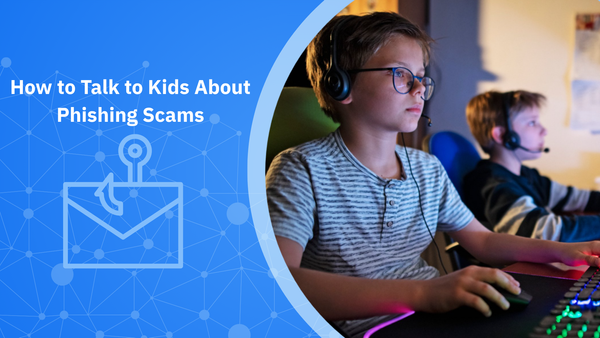How to Talk to Kids About Phishing Scams

Think about this: What would your child do if a message popped up during their favorite game or while scrolling a video app saying, “Win a brand-new iPhone—just click here!”
Would they come and tell you—or try to handle it on their own?
Would they click—or stop and think?
Phishing scams aren’t just a threat to adults. Kids are targets, too. And because they spend so much time online—playing games, chatting with friends, watching videos—they’re right where scammers tend to strike.
In this article, we’ll look at how phishing scams work, why children are vulnerable, how to talk to them about it, and what steps you can take to protect your family.
What Are Phishing Scams?
Phishing is when someone tries to trick you into giving away private information—like passwords, login details, or even money—by pretending to be someone else. These scams usually show up as messages, SMS texts, calls, notifications, or pop-ups that look real but aren’t.
They might pretend to be a game platform, a favorite brand, or even a friend. The goal is to get you to click a link, log in to a fake page, or download something dangerous.
Adults often see phishing in emails, but kids are more likely to come across these scams in games, chats, social media, or apps they use every day.
Related: Phishing Scams: How to Identify and Avoid Them
Why Scammers Target Kids Where They’re Most Vulnerable
Phishing scams rely on two things: trust and curiosity. That’s why they target people of all ages. But children are especially at risk—they’re still learning how the internet works and who they can trust.
Scammers know this. They also know that kids don’t always spot the warning signs. If something looks fun, exciting, or urgent, a child might act fast without stopping to think—and that’s exactly what scammers are counting on.
Kids are most likely to encounter phishing in the places they spend the most time: games, chat apps, and video platforms. Scammers follow trends, study popular games and influencers, and use that knowledge to craft scams that feel familiar and tempting.
Here are a few examples of what phishing scams aimed at kids might look like:
- A message in a game chat offering free in-game currency if they log in to a website.
- A fake giveaway on social media that promises a new iPhone or gaming console.
- A message from someone pretending to be a friend asking for login details.
These scams often pressure kids to act fast: “Only the first 100 people win!” or “Offer expires in 10 minutes!”
Related:
- Holiday Scams Targeting Children: How to Protect Your Family
- Easter-Themed Scams: How Cybercriminals Are Cracking Their Way Into Your Inbox
How to Talk to Your Child About Phishing Scams
You don’t need to scare your child—but it’s important they understand that not everyone online is who they say they are. These conversations don’t have to be formal or serious. Often, a casual moment—while they’re playing a game or scrolling—is the perfect time to bring it up.
Here are some simple ways to start the conversation and help them feel confident asking for help:
1. Keep it simple
Start with a short, clear explanation. Phishing is when someone pretends to be a company, friend, or game platform to trick you into clicking a link or giving away personal info.
What to say:
“Sometimes, people on the internet try to trick you by pretending to be someone else. They might say they’re from your game or your favorite store, but really, they just want your password or personal details.”
2. Ask what they already know
Instead of jumping into a warning, ask questions. This helps your child feel heard and opens up space for a relaxed chat.
What to ask:
“Have you ever seen a message saying you won something, or that you need to log in to keep your account?”
“Has anyone ever sent you a link in a game chat that looked weird?”
Their answers might surprise you—and give you a better idea of what they’ve seen online.
3. Share examples they can relate to
Children learn best through stories. Use real-life examples or made-up ones based on what they like.
Example:
“Imagine you’re playing Roblox and someone messages you saying you’ll get 5,000 Robux if you log in to a website. It looks real—but it’s not. They’re just trying to steal your account.”
“What if someone on TikTok sends you a link to ‘win a free iPhone’—but asks for your name, email, and password to enter?”
You can also tell them about a time you received a phishing message. Kids love when grown-ups admit they don’t always know everything.
4. Practice what to do next
Help them build a habit of thinking before clicking. Use role-play to show what a smart reaction looks like.
What to say:
“If you see a message like that, stop and ask yourself—do I know this person? Did I enter a contest? Does the website look right?”
“If you’re not sure, just come and ask me. You won’t be in trouble.”
You can also teach them to check for clues: bad spelling, weird web addresses, pressure to act fast.
5. Reassure them it’s always okay to ask for help
The most important message: they won’t get in trouble for telling you something strange happened. Even if they clicked on something by mistake.
What to say:
“If something feels off, or if you clicked something and don’t know what to do—come to me. I won’t be mad. I’ll help you figure it out.”
How to Keep Your Family Safe from Phishing
Talking is the first step. But it’s also important to take action. Here’s how you can reduce the chances of your child falling for a phishing scam:
- Teach them the golden rule: Never click on links or give out personal details unless they’re sure who they’re talking to.
- Use strong security settings: Set up privacy and safety controls in games, browsers, and apps.
- Install security tools: Use reliable parental controls and security tools that help block phishing messages, suspicious links, and fake websites. Tools like Bitdefender Parental Control will give you a heads-up when something’s not right, and you can also use it to set healthy internet time limits, filter harmful content, and keep an eye on the apps your child is using. Bitdefender Parental Control is included in all paid Bitdefender family security plans, so you can install it on your child’s device and start managing their online safety right away.
- Stay involved: Ask your child what they’re playing or watching. The more open your conversations, the more likely they’ll come to you if something feels off.
Here are more articles from our “How to Talk with Kids About…” series—each one designed to help you explain tricky online topics in a way that makes sense to your child:
tags
Author
Cristina Popov is a Denmark-based content creator and small business owner who has been writing for Bitdefender since 2017, making cybersecurity feel more human and less overwhelming.
View all postsRight now Top posts
Cybercriminals Use Fake Leonardo DiCaprio Film Torrent to Spread Agent Tesla Malware
December 11, 2025
Genshin Impact Scam Alert: The Most Common Tricks Used Against Players
December 05, 2025
How Kids Get Automatically Added Into WhatsApp Groups with Horrific Imagery Without Consent
November 24, 2025
FOLLOW US ON SOCIAL MEDIA
You might also like
Bookmarks









